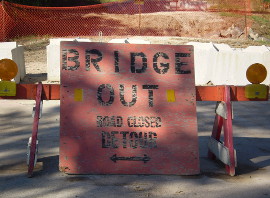Stephen Vance, Staff

Perhaps more concerning is that nearly $6 million of the required bridge infrastructure work was deemed “urgent” by consultants Brian Wickenheiser of Ainley Group, and Derek Ali of DFA Infrastructure, who presented an update on the state of the municipal bridge infrastructure to council.
Their report identified strategies for tackling the bridge infrastructure problem that included the closure of up to 9 of the 80 bridges in the municipality, debt financing, and potentially significant tax increases in the coming years.
“The state of the Municipality’s bridges and culverts is declining,” the consultants concluded in their report. “Four Asset Management Strategies have been identified and are intended to address the Municipality’s bridge and culvert needs over the next 51 years, based on the results of the 2014 and 2015 OSIM inspections.”
The report presented to council this week paints an even more dire picture than just five years ago, when the previous council was advised in October of 2011 that $20 million was needed over ten years, for bridge and culvert repair and replacement in a report that identified necessary projects that included 15 full bridge replacements. At that time, the bridge work identified as requiring immediate attention amounted to $1.1 million over two years.
The consultants advised that of the four asset management strategies identified, the best fit for Meaford will still be a tough pill to swallow.
“Asset Management Strategy No. 4, which includes closure, elimination or download of nine structures, offers the best opportunity for lowering overall costs,” council was advised.
Under that strategy the municipality would spend nearly $80 million on bridges over the next 51 years, an average of $1.5 million per year. Depending how the municipality chooses to finance the bridge work, municipal debt or property taxes will need to increase significantly according to the report. Two financing strategies were identified by the consultants.
“Financing Strategy A (using Base Funding Only) is insufficient in the Long Term, but is sufficient in the Short Term (between 2016 and 2024) to fund the structure needs and repay debt,” read the report, while “Financing Strategy B (using Tax Increases) is sufficient, but would require annual tax increases over the next ten years ranging from 3.7% to 17.6% per year, plus additional tax increases beyond that, dedicated solely to bridges and culverts.”
Faced with the potential for double digit tax increases for decades to come just to finance required bridge work, councillors were understandably less than thrilled with the news.
“Can you define for me, really, what does “urgent” mean?” asked Councillor Shirley Keaveney, referring to the nearly $6 million in required bridge work identified as “urgent” by the consultants. “Does that mean that these bridges are in such a state that they may collapse, or does that mean that they’re just in a state where much more serious deterioration is likely to happen? What does that term really mean.”
Wickenheiser advised that the “urgent” classification identifies bridge work that is deemed necessary within the next 12 months.
“We do have some that, based on their current condition, are at a point that if something’s not done immediately on the structures, they will get to the point that you are not going to be able to rehabilitate them. They’re going to deteriorate further, and the cost to rehabilitate them will be so excessive it will ultimately be cheaper to replace the structure,” advised Wickenheiser.
“These are really frightening numbers,” noted Councillor Keaveney, who asked municipal treasurer Darcy Chapman if the municipality can expect help from upper levels of government.
“This, along with all of the other plans we’ve completed over the last 24 months, once packaged together in the next six months will provide us with a final asset management plan, and from there we’ll be able to determine how we can fund all of our asset needs, and which ones we can’t fund, and from there we’ll be able to go back to the province and the federal government with hat in hand saying we’re doing the best we can, but we still can’t meet all our needs,” advised Chapman.











